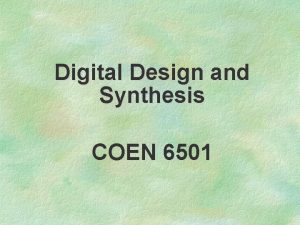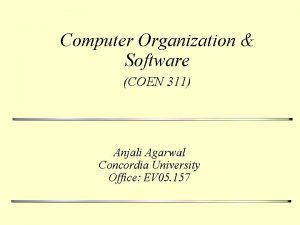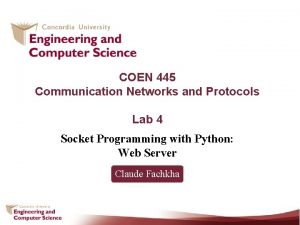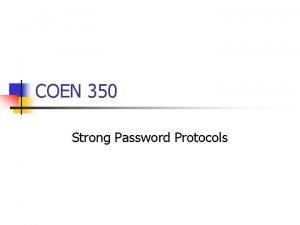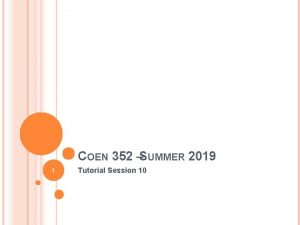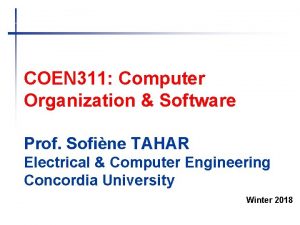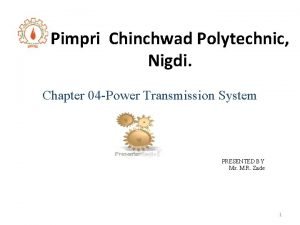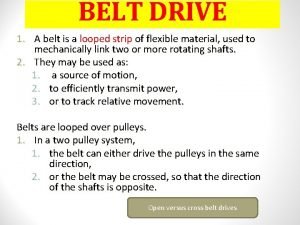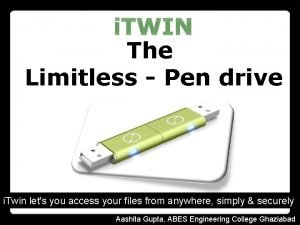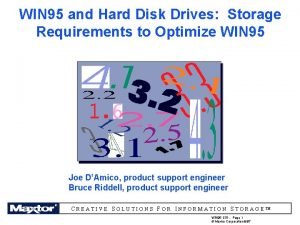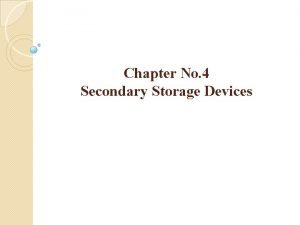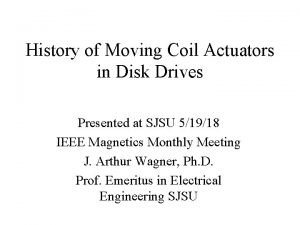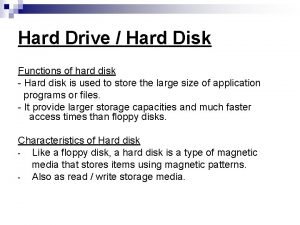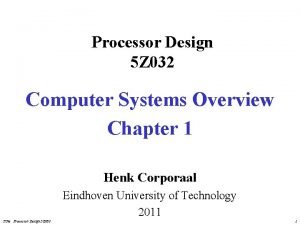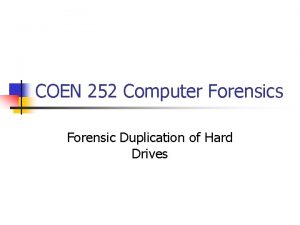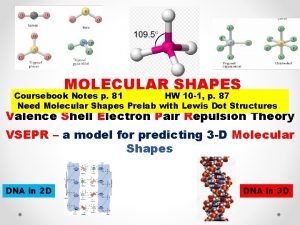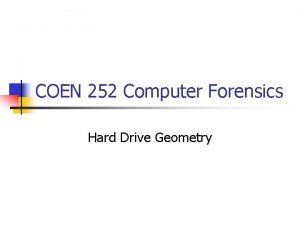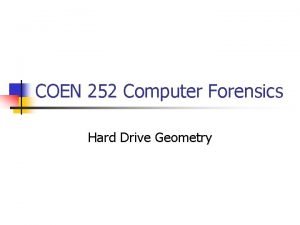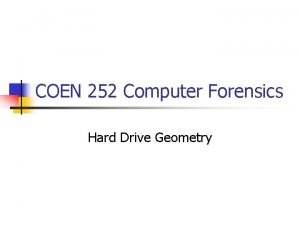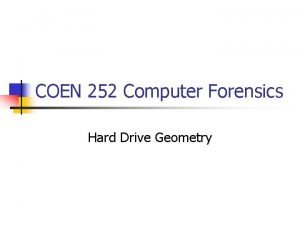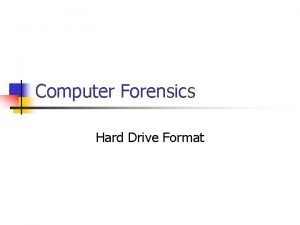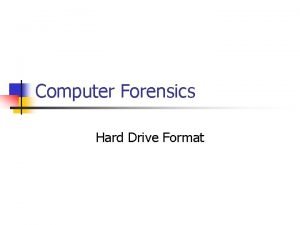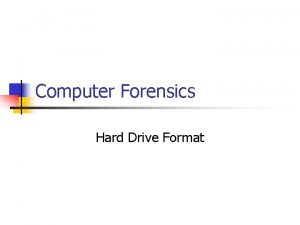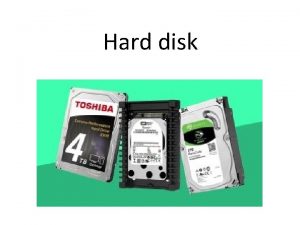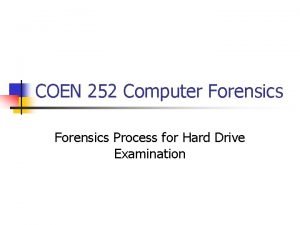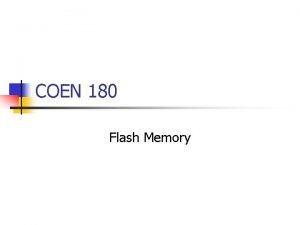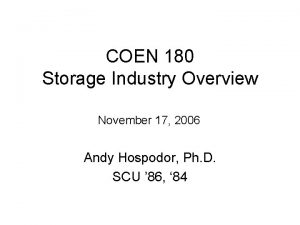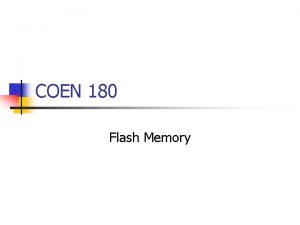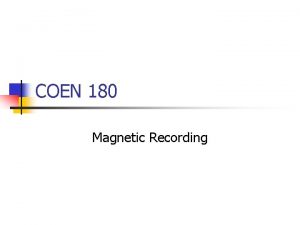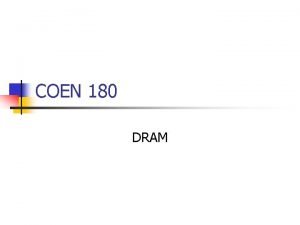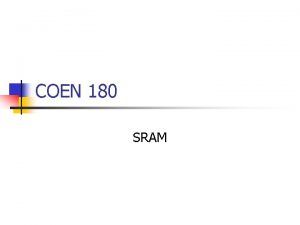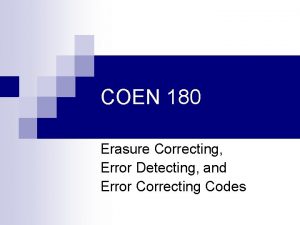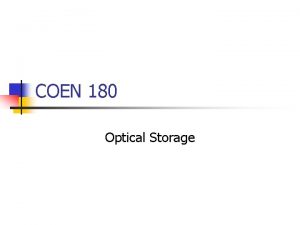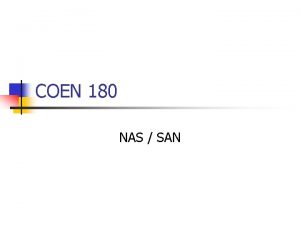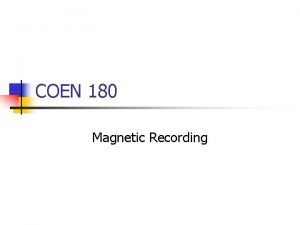COEN 180 Hard Drive Interface Evolution Hard Drive

































- Slides: 33

COEN 180 Hard Drive Interface Evolution

Hard Drive Interface Evolution n Hard Drive Interface n n How does the system interact with the disk. Slow development towards autonomous, intelligent storage devices.

Hard Drive Interface Evolution n ST 412/506 n n Named after two Seagate disks from 1980 and 1981. Adopted by IBM for PC Hard drive accommodates only control circuitry for stabilizing disk rotation and head position. Everything else is controlled by the controller.

Hard Drive Interface Evolution n n Disk interface resides in adapter card. Connected with two cables n n 20 pin data or B cable. 34 pin controller or A cable.

Hard Drive Interface Evolution n ST 412/506 n Write operation (as an example) n n Controller knows the current track. Uses the direction signal and the step signal to move one track at a time. n n If the controller ever looses control of the track, then the controller moves the heads outwards until the drive indicates with the track 00 signal that the head is over the outmost track. Sector identification is in the sector header. Once correct sector is reached, controller sends over the write current. Any type of magnetic code can be used. n n MFM gives a data rate of 5 MHz RLL 7, 2 gives a data rate of 7. 5 MHz.

Hard Drive Interface Evolution n IDE n n 1984: Compaq asked Western Digital to produce an ST 506 controller embedded in the hard drive itself and connected to the system bus via a 40 pin cable. IDE is standardized as the ATA standard.

Hard Drive Interface Evolution

Hard Drive Interface Evolution n IDE implements a register model. n n To the host system, the IDE controller looks like two blocks of I/O registers in the I/O space of the ISA bus. Registers allow the host n n n To control hard drive, To control transfer rate (via PIO or DMA). To receive status messages.

Hard Drive Interface Evolution n IDE PIO command n Sets up a register block n n Writes IDE address register Writes Drive / Head register n n Which contains bits for the head number. Writes sector count register. Writes feature register. Etc.

Hard Drive Interface Evolution n IDE PIO command n n n n n Sets up a register block Sends the write command to disk. Drive responds by setting DRIVE READY bit in the status register. Host writes data via the data register to the sector buffer. When the sector buffer is full, then the disk drive sets the BUSY bit in the status register. Data is written to the medium. Drive deasserts the BUSY bit and sets the INTRQ bit. That signals the host to read the status register. Status register (hopefully) indicates a successful write.

Hard Drive Interface Evolution n IDE has two addressing modes: n Physical Addressing Mode (CHS) n n Cylinder Head Sector Logical Addressing Mode (LBA) n LBA - Logical Block Address LBA = (Cylinder. Number*Head. Count+Head. Number)*Sector. Count + Sector. Number - 1.

Hard Drive Interface Evolution n SCSI n n n 1979: Disk drive manufacturer Shugart proposes a new interface. 1986: ANSI approves the first SCSI standard. SCSI in many variations remains the primary interface for enterprise class storage devices.

Hard Drive Interface Evolution n SCSI n Has an IO bus. n n n With originally 8 devices. SCSI interfaces exists for many storage devices. Example: First RAIDS had strings of disks hanging from a single SCSI bus.

Hard Drive Interface Evolution n SCSI has its own language. SCSI address is a SCSI ID. Device with a single SCSI ID can consist of LUNs (Logical UNits) n n Originally 8 LUNs per SCSI ID Devices are either n n Targets. Initiators. n n n Tells target what to do. Computer system is connected to SCSI bus through an HBA (Host Bus Adapter). Peripherals have a controller instead.

Hard Drive Interface Evolution

Hard Drive Interface Evolution n SCSI standards n SCSI-1 (1986) n Two transfer rates n n n SCSI-2 (1990/1994) n n n Asynchronous transfer (1. 5 MHz to 4 MHz) Synchronous transfer (5 Mhz) Fast (Synchronous) SCSI (10 MHz) Wide (16 b to 32 b transfers with additional B-cable. SCSI-3 (since 1993) n Family of standards, including Fibre Channel, IEEE-1394

Hard Drive Interface Evolution SCSI-3

Hard Drive Interface Evolution n Asynchronous transfer n Sender and receiver exchange data using the request / acknowledge handshake.

Hard Drive Interface Evolution n Asynchronous Transfer n n n Sender asserts data. Sender asserts REQ when data is stable. Receiver asserts ACK. Sender deasserts data and REQ. Receiver deasserts ACK. Transmission of 1 bit followed by 0 bit on a single data line with a handshake protocol.

Hard Drive Interface Evolution n n Synchronous Transfer Sender and Receiver negotiate a clock rate at which data is send.

Hard Drive Interface Evolution n Synchronous transfer example n From target to initiator n Target pulses REQ 5 times at a fixed rate. n n Assume 5 is the REC/ACK offset. Initiator sends 5 pieces of data. Initiator validates the data by pulsing ACK when data is stable. Target reads data and sends an acknowledgment by pulsing REQ.

Hard Drive Interface Evolution

Hard Drive Interface Evolution n SCSI bus width n n n Originally 8 b. Extended to 16 b and 32 b. Currently, serial transfer (one data bit at a time) is fastest because of lack of interference.

Hard Drive Interface Evolution Name Specification # of Devices Bus Width Bus Speed MBps Asynchronous SCSI-1 8 8 b 5 MHz 4 MBps Synchronous SCSI-1 8 8 b 5 MHz 5 MBps Wide SCSI-2 16 16 b 5 MHz 10 MBps Fast SCSI-2 8 8 b 10 MHz 10 MBps Fast/Wide SCSI-2 16 16 b 10 MHz 20 MBps Ultra SCSI SCSU-3 SPI 8 8 b 20 MHz 20 MBps Ultra/Wide SCSI SCSU-3 SPI 8 16 b 20 MHz 40 MBps Ultra 2 SCSI SCSU-3 SP 2 8 8 b 40 MHz 40 MBps Ultra 2/Wide SCSI SCSU-3 SP 2 16 16 b 40 MHz 80 MBps Ultra 3 SCSI SCSU-3 SP 2 16 16 b 40 MHz 160 MBps

Hard Drive Interface Evolution n HBA n n n Gives system access to a SCSI bus System can have many HBAs. Storage Area Network: n Addresses n n n Bus Target LUN

Hard Drive Interface Evolution n Devices are either initiator or target. n n n Originally, a device was either one or the other. Now, they can be both. Example: n n Tape drive is target when the system sends it a command. When the tape is ready to perform the command, it might become the initiator and the system the target.

Hard Drive Interface Evolution The initiator is the master in the function and the slave in protocol, the target is the slave in function and the master in protocol" (M. Schultz).

Hard Drive Interface Evolution n SCSI cables n n A cable has 50 pin B cable has 68 pins in SCSI 1.

Hard Drive Interface Evolution n n SCSI cables 3 different versions of cabling: n Single-ended (SE) – n n High-voltage differential (HVD) – n n The most common form of signaling for PCs, single-ended signaling means that the controller generates the signal and pushes it out to all devices on the bus over a single data line. Each device acts as a ground. Consequently, the signal quickly begins to degrade, which limits SE SCSI to a maximum of about 10 ft (3 m). The preferred method of bus signaling for servers, HVD uses a tandem approach to signaling, with a data high line and a data low line. Each device on the SCSI bus has a signal transceiver. When the controller communicates with the device, devices along the bus receive the signal and retransmit it until it reaches the target device. This allows for much greater distances between the controller and the device, up to 80 ft (25 m). Low-voltage differential (LVD) – n A variation on the HVD signaling method, LVD works in much the same way. The big difference is that the transceivers are smaller and built into the SCSI adapter of each device. This makes LVD SCSI devices more affordable and allows LVD to use less electricity to communicate. The downside to LVD is that the maximum distance is half of HVD -- 40 ft (12 m).

Hard Drive Interface Evolution n SCSI bus uses phases in order to transmit data or messages.

Hard Drive Interface Evolution n n Bus free phase. Arbitration phase n n n one or more initiators indicate that they would like to use the bus. If more than one initiator enters the arbitration phase, the one with the highest SCSI ID wins. Selection phase, n n Initiator puts the address of the target onto the data bus. (The reselection phase fulfills a similar function, after winning arbitration, a target that released the bus to execute a command can reestablish the connection to the initiator. )

Hard Drive Interface Evolution n Four phases for exchanging data: n n command phase is used for transferring command opcodes, data phase is used for transferring data bytes, message phase allows sending or receiving information concerning the protocol itself, status phase concludes a command gives the status of the operation back to the initiator.

Hard Drive Interface Evolution n SCSI Commands n n Plethora of different commands. Formatted in various formats, like TCP/IP 00001000 LUN DPO FUA Reserved Rel Logical Block (LSB) Reserved Transfer Length Control Byte
 Hard drive evolution
Hard drive evolution Slide to doc.com
Slide to doc.com Googlehttps://drive.google.com/drive/my-drive
Googlehttps://drive.google.com/drive/my-drive Understanding google drive
Understanding google drive Hard times hard drive
Hard times hard drive Coen 6501
Coen 6501 Anjali agarwal concordia
Anjali agarwal concordia Coen 445
Coen 445 Lab 3: smtp lab
Lab 3: smtp lab Coen 445
Coen 445 Coen 352
Coen 352 Coen311
Coen311 User led through interaction via series of questions
User led through interaction via series of questions Interface------------ an interface *
Interface------------ an interface * Office interface vs industrial interface
Office interface vs industrial interface Interface in java
Interface in java Http drive google com
Http drive google com Difference between belt drive and chain drive
Difference between belt drive and chain drive Crossed belt drive
Crossed belt drive Https drive google com drive u 0 recent
Https drive google com drive u 0 recent Https drive google com file d 0b8f5bmoit8kbmx
Https drive google com file d 0b8f5bmoit8kbmx Itwin limitless pendrive technology
Itwin limitless pendrive technology Win95 requirements
Win95 requirements Printer is needed to
Printer is needed to Hard drive voice coil
Hard drive voice coil Tvs diode hard drive
Tvs diode hard drive Floppy disk drive function
Floppy disk drive function Nkb032 sensor
Nkb032 sensor How to maintain a qualified forensic duplicate?
How to maintain a qualified forensic duplicate? What makes hard water hard lab investigation 3 answers
What makes hard water hard lab investigation 3 answers Work hard play hard make history
Work hard play hard make history Tangens 180
Tangens 180 Non bonding electrons examples
Non bonding electrons examples 180 testo
180 testo





